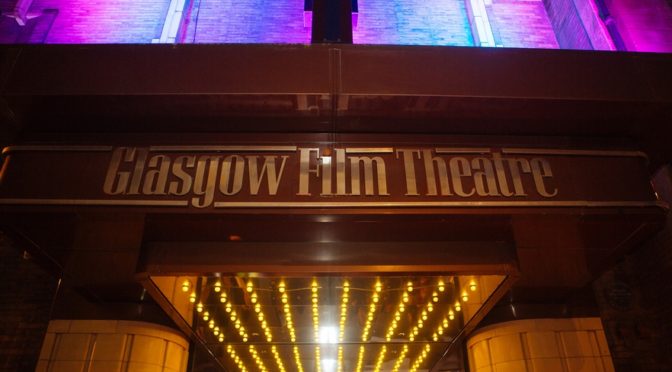May 2019 marks 80 years since the opening of Glasgow Film Theatre (GFT). From 1939 until 1974, however, it was known as the Cosmo, and its first screening was Julien Duvivier’s UN CARNET DE BAL (LIFE DANCES ON). The Modernist European building, with a post-art deco interior featuring lots of mirrors, is protected on account of its historical importance. Stepping into the foyer feels a bit like stepping into a past time before things like IMAX and 3D came into being. It would be wrong, however, to call GFT – now a beloved feature of Glasgow – old-fashioned. In fact, a recent renovation saw the venue improve its accessibility, and it regularly hosts autism-, deaf- and dementia-friendly screenings, thereby adhering to its motto of Cinema For All inscribed into a globe on the cinema foyer floor.
In 1991, GFT’s second screen was built, whilst 2013 saw the creation of Cinema 3. Through the years, countless celebrities have stepped through its doors, from Alan Rickman to David Tennant and from Quentin Tarantino to Joss Whedon. GFT hosts not only the annual Glasgow Film Festival, but also the Glasgow Short Film Festival and Glasgow Youth Film Festival, along with many other festivals throughout the year, such as the Scottish Queer International Film Festival.
To celebrate 80 years of cinema, earlier this month GFT held special free screenings of four films that represent the breadth of GFT’s programming, as well as the changes in film since 1939. Released in the same year as the Cosmo opened, family favourite THE WIZARD OF OZ’s use of Technicolor was strikingly modern for its time, and on 11 May GFT screened it again in 4K resolution. GFT is one of the few Scottish cinemas still projecting regularly from 35mm and 70mm, allowing it show both retrospectives and new features – for instance, Christopher Nolan’s DUNKIRK – the way their creators intended them to be viewed. GFT’s passion for cinema is matched by the CINEMA PARADISO in Giuseppe Tornatore’s 1988 film of the same name, which was also screened as part of ’80 Years’, along with David Lynch’s classic MULHOLLAND DRIVE from 2001. In 2017, Lynch was featured in GFT’s regular CineMasters programme, a strand of retrospective screenings that have also featured Margarethe von Trotta and Stanley Kubrick. GFT also previewed Olivia Wilde’s directorial debut BOOKSMART, which heralds a new era in comedy, one that is progressive, feminist, but also hilariously rude.
“GFT was Scotland’s first arthouse cinema, but when it opened as the Cosmo there were 114 cinemas in Glasgow, so it had a lot of competition.”
GFT was Scotland’s first arthouse cinema, but when it opened as the Cosmo there were 114 cinemas in Glasgow, so it had a lot of competition. In 1939, Glaswegians went to the cinema an average of 51 times a year, compared to 35 times for the rest of Scotland. That passion for film has not abated, and among GFT’s most popular screenings in recent years were THE ARTIST (2012), T2 TRAINSPOTTING (2017) and ISLE OF DOGS (2018). You can even get married in the GFT: Over the years, six weddings have been held in Cinema 2.
The 1930s was an exciting decade for Scottish cinema: in 1934, the Perth Playhouse opened, whilst in 1938, Edinburgh’s Dominion Cinema opened its doors for the first time. In 1939, meanwhile, in the same year as the Cosmo, Birks Cinema in Aberfeldy opened. Both the Cosmo and Birks Cinema opened just a few months before the start of World War II – a sign, perhaps, of the importance of film in troubling times.
All of these cinemas continue to screen films to this day (although in the case of Birks Cinema, after a 30-year hiatus), but GFT is unique among them in eschewing big box-office beasts. Like the Edinburgh Filmhouse, which opened in 1979, Glasgow Film Theatre should be celebrated not only for making cinema accessible for all, but also for ensuring that Glaswegian cinephiles can enjoy a true range of over 700 films from across the world every year, and hopefully for another 80 years and beyond.


One thought on “80 Years of Glasgow Film Theatre”
Comments are closed.